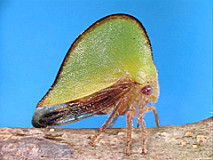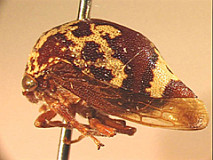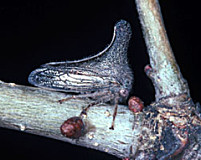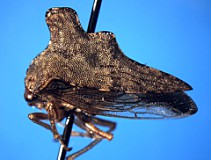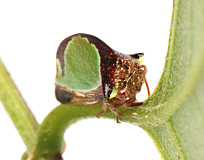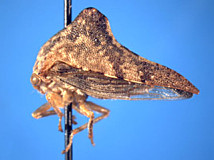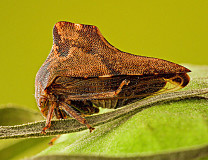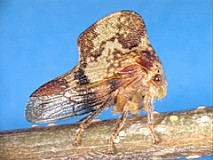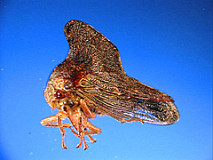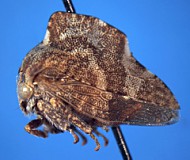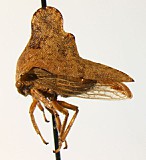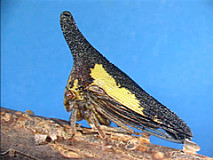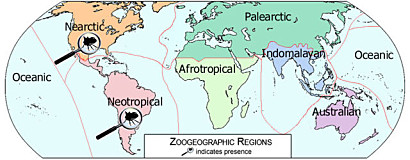Goding 1892a
Funkhouser 1927f
Funkhouser 1951a
Metcalf and Wade 1965a
Deitz 1975a
McKamey 1998a
Wallace 2011a
McKamey and Wallace 2015a
Wallace 2015a
Wallace 2015b
Animalia → Arthropoda → Insecta → Pterygota → Hemiptera → Auchenorrhyncha → Cicadomorpha → Membracoidea → Membracidae → Smiliinae
Telamonini Goding, 1892
Selected references
Overview
Wallace (2011a) gave an extensive overview and morphological phylogenetic analysis of this tribe and its relatives. McKamey and Wallace (2015a) found that records of Telamona from South America are incorrect, either being assigned to an incorrect genus or representing Nearctic species.
Taxon history
Goding (1892a) distinguished the tribe Telamonini from the Smiliini by the presence of crossvein r-m in the hind wing of members of the former, however, Deitz (1975a) treated Telamonini as a junior synonym of Smiliini. Wallace (2011a) reinstated Telamonini as a valid tribe. With recent changes (Wallace 2015a, 2015b), the tribe now has 10 genera (see “Taxonomic constituents,” below). Although the tribe Telamonini is not yet distinguished from the Smiliini in Wallace’s 2010a online key to the treehopper tribes of the United States, “Diagnostic characters” that define the Telamonini sensu Wallace 2011 are given below.
Taxon images
Telamonini
Acoustic calls
Distribution
Neotropical and Nearctic regions: at least six of the ten included genera occur only in the Nearctic region.
Diagnostic characters
Head dorsal margin with abrupt rise near eyes. Pronotum concealing much of forewing in repose, usually modified with anterior median horn or projection (exceptions: Archasia and Mutilifolia with pronotum highly elevated and foliaceous; Carynota with pronotum relatively simple), enlarged humeral angles (not suprahumeral horns), and longitudinal rugae; median carina complete or incomplete. Forewing with veins R, M, and Cu separate near base, but crowded anteriorly (without large cells separating them); vein R4+5 confluent with M distad of M fork; with 2 or more m-cu crossveins. Hind wing with veins R4+5 and M1+2 free (if fused, only for short distance). Female second valvulae narrow and elongate; dorsal margin with 3 large, evenly spaced teeth; dorsal and ventral margins converging proximally; apex acuminate. Length of female almost always 8 mm or more.
Host plants
Many telamonine species feed on Fagaceae, especially on various species of oak (Quercus). Additional host families include: Betulaceae, Cornaceae, Fabaceae, Hamamelidaceae, Juglandaceae, Oleaceae, Platanaceae, Rosaceae, Salicaceae, Tiliaceae, Ulmaceae, Verbenaceae, and Vitaceae (Wallace 2011a).
Behavior
Most members of the tribe Telamonini (like most Smiliini) are solitary as nymphs and adults, monophagous, and univoltine (Wallace 2011a). Funkhouser (1917a) listed Telamona ampelopidis, T. unicolor, and Thelia bimaculata as species attended by ants.
Taxonomic constituents
Archasia Stål, 1867 Stål, 1867
Carynota Fitch, 1851 Fitch, 1851
Glossonotus Butler, 1877 Butler, 1877
Heliria Stål, 1867 Stål, 1867
Mutilifolia Wallace, 2015 Wallace, 2015
Palonica Ball, 1931 Ball, 1931
Telamona Fitch, 1851 Fitch, 1851
Telamonanthe Baker, 1907 Baker, 1907
Telonaca Ball, 1918 Ball, 1918
Thelia Amyot and Serville, 1843 Amyot and Serville, 1843
Prepared by
Matthew S. Wallace, Lewis L. Deitz, and Mark J. Rothschild, 15 Sept 2015.


